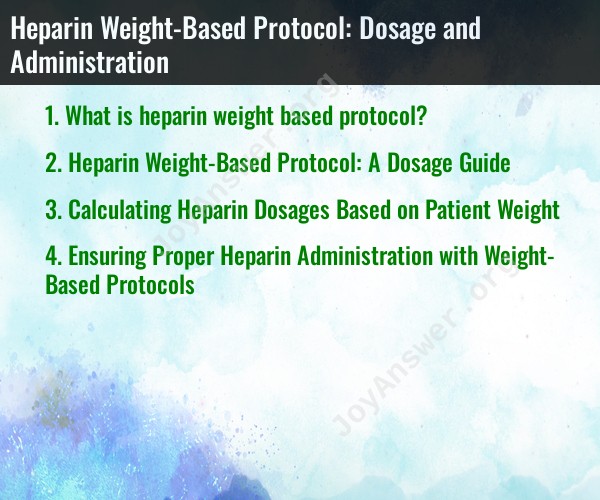What is heparin weight based protocol?
A heparin weight-based protocol is a medical dosing strategy for the administration of the anticoagulant medication heparin, which takes into account a patient's body weight to determine the appropriate dosage. This approach aims to provide a more personalized and effective treatment while minimizing the risk of complications, such as bleeding or clotting.
The general idea behind a heparin weight-based protocol is to calculate the heparin dosage in units per kilogram of the patient's body weight. This dosage is then often administered as a continuous intravenous (IV) infusion. The key steps in implementing a weight-based heparin protocol typically include:
Assessment: The patient's weight is determined and recorded.
Calculating the Initial Dose: The healthcare provider calculates the initial heparin dosage based on a specific number of units per kilogram of the patient's body weight. The exact formula or guidelines may vary between healthcare institutions.
Continuous Infusion: Heparin is usually administered as a continuous IV infusion, allowing for precise control over the anticoagulation effect. The initial dosage is delivered, and the patient's response to the medication is monitored.
Monitoring and Adjusting: The patient's blood clotting parameters, such as activated partial thromboplastin time (aPTT) or partial thromboplastin time (PTT), are regularly monitored. The heparin infusion rate may be adjusted to keep these parameters within the target therapeutic range.
Preventing and Managing Complications: Healthcare providers closely monitor patients for signs of bleeding or thrombosis, as heparin can affect blood clotting. Adjustments to the heparin dose may be made to maintain the desired anticoagulation effect while minimizing risks.
The benefit of a weight-based heparin protocol is that it allows for more individualized and precise dosing, as people vary in body size and metabolism. This approach can help reduce the risk of both inadequate anticoagulation (which may lead to clot formation) and excessive anticoagulation (which may lead to bleeding complications).
It's important to note that the specific dosing calculations and target therapeutic ranges can vary between healthcare institutions and guidelines, so healthcare providers should follow their institution's protocols when using a weight-based heparin protocol. Patients should always follow their healthcare provider's instructions and be monitored closely during heparin therapy.
Heparin Weight-Based Protocol: A Dosage Guide
A heparin weight-based protocol is a set of guidelines for determining the appropriate heparin dosage for a patient based on their weight. Heparin is a blood thinner that is used to treat and prevent blood clots. It is important to use the correct heparin dosage to avoid serious side effects, such as bleeding.
Calculating Heparin Dosages Based on Patient Weight
To calculate a heparin dosage based on patient weight, you will need to know the patient's weight in kilograms (kg) and the desired activated partial thromboplastin time (aPTT) goal. The aPTT is a blood test that measures how long it takes for a blood clot to form.
The following formula can be used to calculate a heparin dosage based on patient weight:
Heparin dosage (units/kg/hour) = (Desired aPTT goal - Patient's current aPTT) / (Target aPTT range)
The target aPTT range for heparin therapy is typically 60-85 seconds.
Ensuring Proper Heparin Administration with Weight-Based Protocols
To ensure proper heparin administration with weight-based protocols, it is important to:
- Use the correct heparin dosage for the patient's weight and desired aPTT goal.
- Administer heparin as prescribed by a healthcare provider.
- Monitor the patient's aPTT closely and adjust the heparin dosage as needed.
Example of a Heparin Weight-Based Protocol
The following is an example of a heparin weight-based protocol for the treatment of deep vein thrombosis (DVT):
- Initial heparin dosage: 80 units/kg SQ every 12 hours
- Target aPTT range: 60-85 seconds
- Monitor aPTT 6 hours after the initial heparin dosage and then every 6-12 hours thereafter
- Adjust heparin dosage as needed to maintain aPTT within the target range
It is important to note that this is just an example of a heparin weight-based protocol. The specific heparin dosage and monitoring schedule may vary depending on the patient's individual needs.
Conclusion
Heparin weight-based protocols can help to ensure that patients receive the correct heparin dosage to achieve the desired therapeutic effect. It is important to use the correct heparin dosage for the patient's weight and desired aPTT goal, administer heparin as prescribed by a healthcare provider, and monitor the patient's aPTT closely.













